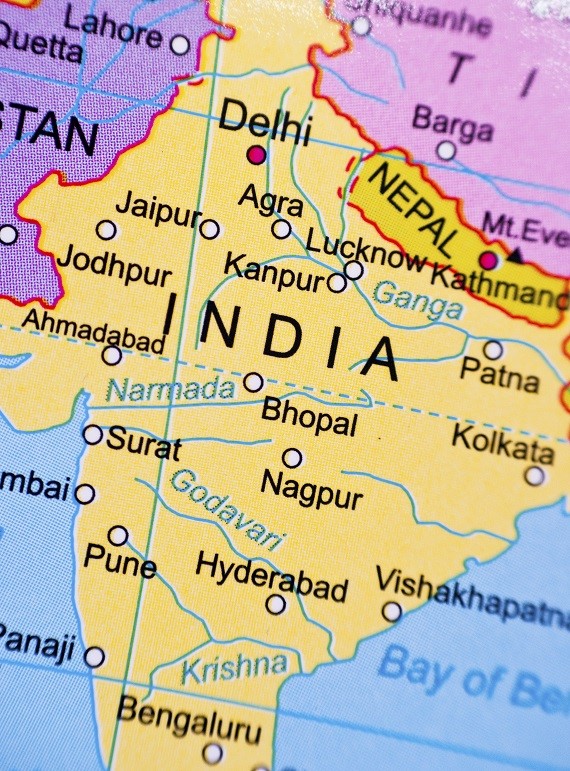
It is October 9th and I have boarded my American Airlines flight headed for Delhi via London. I am so excited to be traveling to India for the 3rd time. This trip takes me to Delhi, Khajuraho, Varanasi, Agra and Jaipur. I will do my best to keep up with my blogs but I will not promise that tomorrows may not show up for a month.
Well that was my intention on October 9th, to blog every day of my 20 day journey only to find that there was no connections and therefore impossible. I will now do my best to tell you about my trip now that I have returned to Plano. I hope you will enjoy.

I arrived at the Delhi airport late in the evening and gathered my bag…so glad it made it as I had changed planes in London and bag transfers aren’t always a sure thing! My ride which was to have been waiting was nowhere to be found. Good news is I had also set up the transfer from the airport to the hotel for the girl that would be meeting me in two hours. I saw the guy holding the sign with her name on it and asked him if he would take me to the Marriott and then come back to the airport and get her. He agreed.

I arrived at the beautiful J.W. Marriott at about 1am and checked in. It was just a short ride from the airport in a new area of big hotels.

It was very quiet as it was so early and I had a handful of wonderful people that checked me in and escorted me to my room.

Of course as I walked through the lobby to my room the beautiful flower arrangements made me stop to take pictures to send to my friends that just opened Fiore x 7, a flower bar in Plano. Once I got to my room I quickly checked out (fell asleep). At about 3am my traveling buddy, Jane arrived. She had traveled from Michigan and we decide to talk in the morning.
In the morning, while Jane was still sleeping, I went to the gym to workout. I got back to my room and showered and by then Jane was up getting ready. Knowing we had a tour the following day, we decide to get to know each other over breakfast. Marge at the Himalayan Institute had been so kind as to introduce us to each other after we both inquired as to whether there was anyone else who had signed up for the pilgrimage that wanted to spend a few days in Delhi prior to the retreat.
After returning to the room after a wonderful breakfast, the concierge called and told us that our guide was waiting for us in the lobby. Wait! Our tour is tomorrow, correct? I checked my paperwork and saw that I was wrong, the tour was set up for today! Yikes! We grabbed our bags and cameras and off we went.
Why Delhi? Well for one thing, I have never been here and this is where my plane was landing to make connections to my retreat in Khajuraho. But more so because of its vast history. I have planned to see some really old stuff and some not so old, but beautiful and intrigueing sites.
Delhi has remained the pivot of northern India for more than a thousand years. The triangular swathe of land that lay between the Aravalli Hills and the Yamuna was not only fertile, it commanded the vital trade route from the north-western mountains to the agriculturally abundant Ganga plains.
The area had housed settlements for several millennia. Paleolithic implements have been discovered in 1991 from Anangpur near Surajkund, considered one of the biggest prehistoric sites in India.
The earliest literary references identify the city with the mythical Indraprastha, a grand township built by the heroes of the epic Mahabharata, the five Pandava brothers. After clearing the deep and impenetrable Khandava forest. An oral tradition relates the story of the five villages the Pandavas had been given by the Kauravas, one of which was Indrapat. And, in fact, when the Purana Qila (Old Fort) was being cleared of squatters in 1911, officials found a village inside the Fort called Indrapat.
That information found through World Heritate Series booklets was enough to make me want to get to know this part of India.
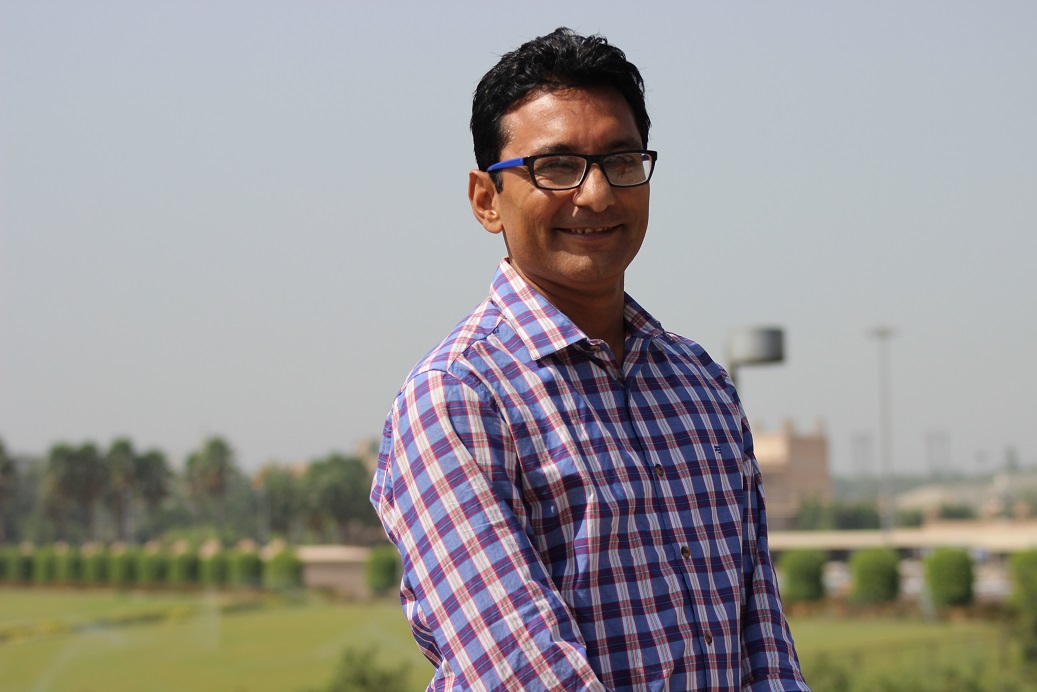
We met our guide, Navine, downstairs and came up with an itinerary.
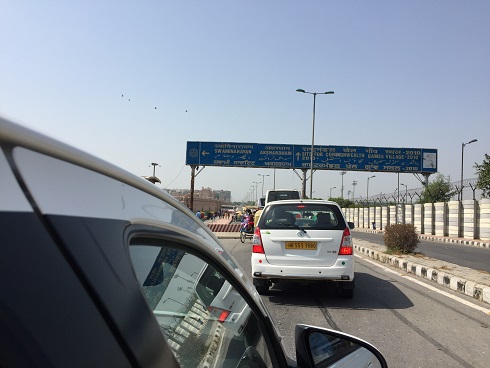
First stop, Swaminarayan Akshardham Temple. The pictures alone will make you want to go there and I was quite confused as to why this temple was so different than other temples I had visited so far in India. The story sheds some light.

As we drove up to the parking area, this beautiful Indian girl waves to us. The people here are so friendly, always smile at you and want to talk. It was a nice morning “hello”.
Swaminarayan Akshardham Temple

Swaminarayan Akshardham means eternal abode of Bhagwan Swaminarayan (1781-1830) a torchbearer of Indian culture and spirituality. Thus this temple was not for a deity (God or Goddess) but to a man whose people considered him a God.
Bhagwan Swaminarayan was born in 1781 in the village of Chhapaiya, near Ayodhya in north India. At the age of eight he was given the sacred thread, and thereafter he completed the study of Sanskrit grammar, the Vedas, Upanishads, Bhagvad Gita, Dharmashastras, Purans, and Shad-Darshans within three years. He left home at the tender age of 11 to guide and elevate mankind. For the next 7 years he traveled 12000 km (or around 7500 miles) in his spiritual travels. He did not get satisfactory answers till he reached Ramanand Swami’s ashram at Loj in Saurashtra (Gujarat). At the age of 21, he was named as the head of the Sampraday by Ramanand Swami and after Ramanand Swami passed away, Sahajanand Swami (as he was originally known) gave the Swaminarayan mahamantra (great thread) to his congregation. Thereafter, he became popularly known as Bhagwan Swaminarayan. From the age of 21 to 49, he and his 3000 paramhansas spearheaded a moral, social and spiritual renaissance in Gujarat. He had a following of over two million devotees.
Near the banks of the Yamana River in New Delhi, this incredibly beautiful temple was built in just five years. This 100 acre complex took over 300 million man hours to carve the 300,000 stones it took to complete.
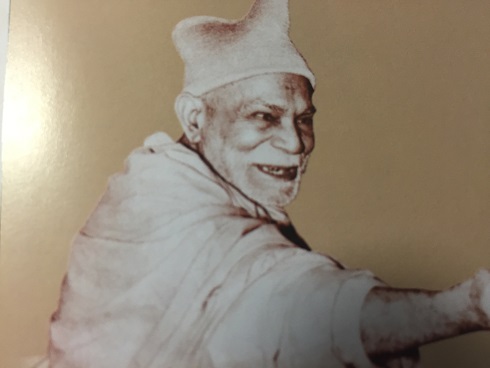
This grand cultural complex was inspired by His Holiness Pramukh Swami Maharaj (Swamishri) to fulfill the wish of his guru, Yogiji Maharaj.
Santish Gujural, an internationally known architect of India, comments that it would have taken 50 years to build such a complex. Swaminarayan Akshardham is an incredible feat of management from acquiring the land in New Delhi to the logistics of construction: the stones were quarried in Bansipahadpur (400 km away or 248 miles), and carved in Pindvada (600 km or 373 miles), Sikandra (250 km or 155 miles) and 24 other rural workshops in Rajasthan. After being transported to Delhi, each stone was assembled like a giant jigsaw puzzle. Millions of hours of dedication and hard work by 11000 sadhus, volunteers and artisans had gone into the concept and making of the monument.
The focal point of the entire complex is the grand Akshardham Monument, built of pink sandstone and white marble. It is 141 ft. tall, 316 ft. wide and 356 ft. long and has 234 intricately carved pillars, 9 magnificent domes, 20 pinnacle and over 20,000 superbly sculpted figures.
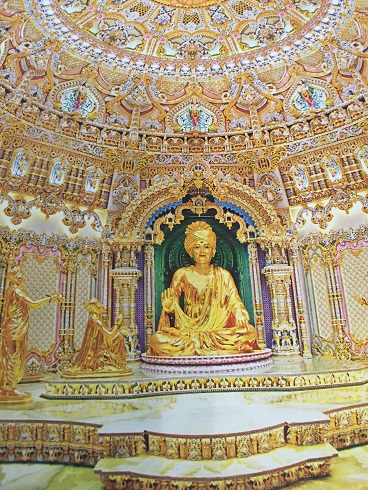
At the center of the monument is the serene 11 ft. high golden murti of Bhagwan Swaminarayan. This picture doesn’t even come close to the beauty of this statue. You can imagine, 11 feet tall. It is mindblowing and you are awe-struck for a few minutes. The monument is surrounded by a sacred body of water called the Narayan Sarovar. The Narayan Sarovar is a holy water body with ghats (a wide set of steps descending to a river especially a river used for bathing) and lotus flowers. The sacred waters of 151 rivers and lakes of India flow from 108 gaumukhs into the Narayan Sarovar, creating an ambience of a place of pilgrimage.
Alongside the murti rooms are two exhibition halls that convey the message of India’s heritage. The Hall of Values or Sahajanand Darshan brilliantly shows the values of ahimsa, courage, endeavor honesty, harmony and faith from the life of Bhagwan Swaminarayan. The second hall shows a film through 10,000 years of Indian culture which flourished on the banks of the river Sarasvati. Eight hundred statues bring India’s glorious heritage to life.
The cultural garden has 22-acres of lush lawns and trees and flowering plants nurtured in the on-site nursery. More than 900,000 saplings and shrubs of 250 varieties were planted to create an environmental delight.
The Ten Gates
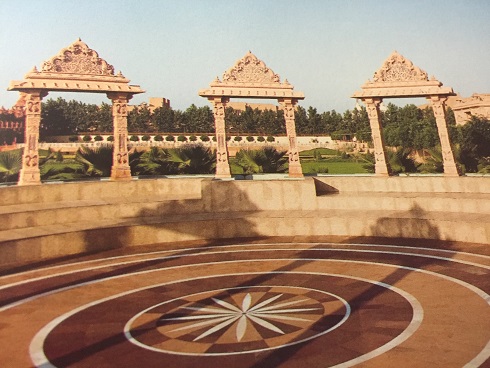
Along the welcome pathway are the Ten Gates, representing the ten directions, symbolizing freedom of thought in Sanatan Dharma as reveled in the Rig Veda, “Let noble thoughts come to us from all sides?”
The Bhakti Dwar
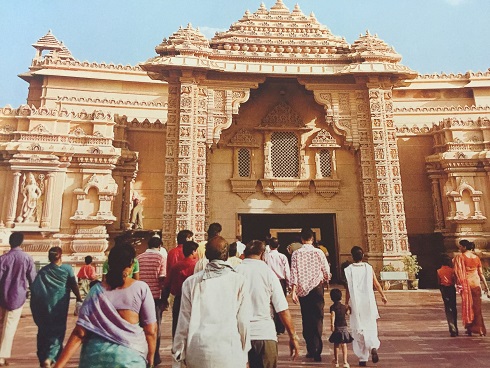
The Bhakti Dwar celebrates the Indian tradition of devotion with 208 sculpted dual forms of God and His ideal Devotee.
Mayur Dwar
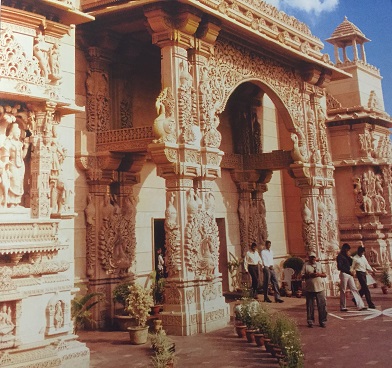
The two Mayur Dwar (Peacock Gates) pay tribute to the joy and beauty peacocks contribute to nature. A total of 869 stone peacocks in different shapes and sized adorn each of the beautiful gates.
Ceilings & Domes
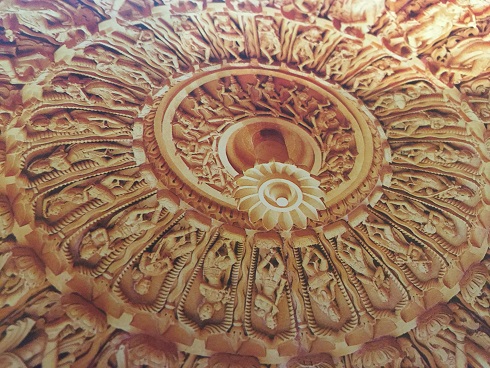
A saga of more than 300,000 stones, each shaped and carved in brilliant and intricate array of sculptures and designs. In the main monument, domes spanning 32 ft., pillars rising to 100 ft. and the mandovar wall totaling 600 ft. in length were all hand carved by craftsmen endowed with a legacy of thousands of years old.
Gajendra Peeth
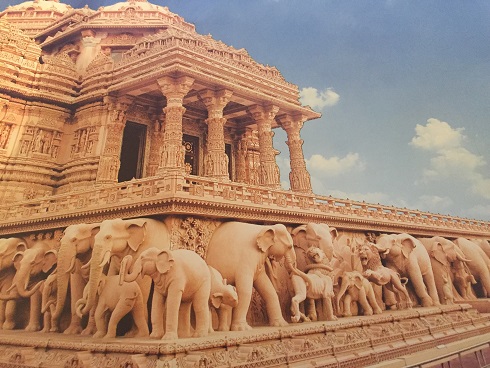
A fascinating 1070 ft. long pageant of elephants in stone. It portrays elephants with nature, man and God, reflecting the message of peaceful coexistence, love, faith, effort, courage and service.
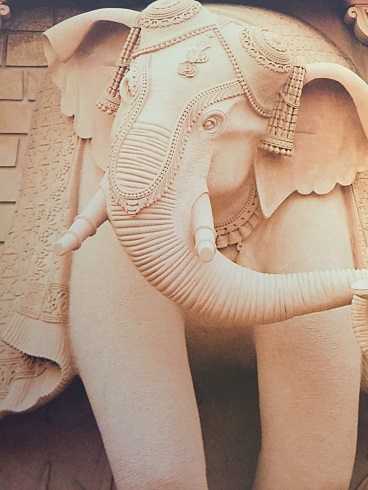
The Gajendra Peeth exhorts mankind towards nobler living and love in nature.
Mandovar
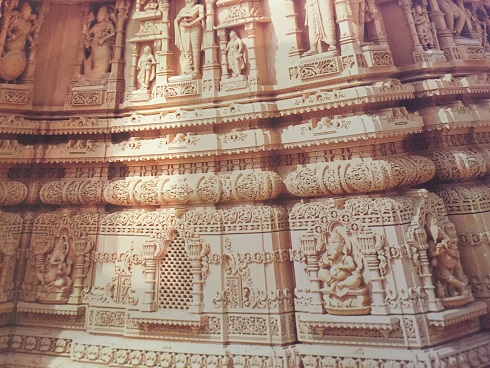
The ornate external wall of the Swaminarayan Akshardham monument is known as the mandovar. It is the largest, most intricately carved mandovar built in India in the past 800 years and is 610 ft. long and 25 ft. high. It features 200 sculptured stone figures on India’s great rishis, sadhus, devotees, acharyas and avatars.
Deities of Sanatan Dharma
Together with Bhagwan Swaminarayan, the other deities of Sanatan Dharma are featured here:

Shri Rama and Sita and their son Hanuman;
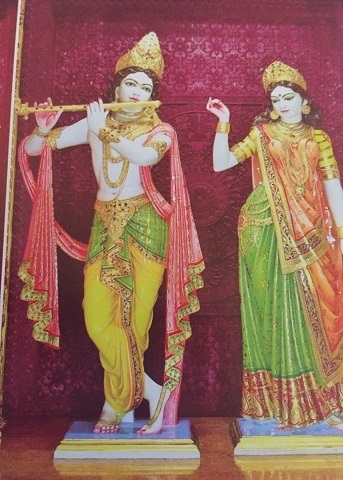
Radha and Krishna

Narayan and Lakshmi and
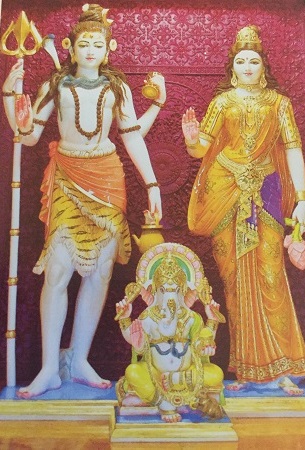
Shri Shiva and Pravati and their son Ganesha.
Yogihriday Kamal
Yogihriday Kamal is an 8 pedaled lotus-shaped arena that pays tribute to the auspicious sentiments of Yogiji Maharaja (the visionary behind Swaminarayan Akshardham). Each petal displays quotes of distinguished sages, scientists, historians, and statesmen, inspiring faith in God and faith in man.
There are many sections on which we did not visit, ones that told about Swaminarayan’s journey, movies, and even boat rides. Our time was limited so we decided to save those areas for another time.
Visiting Swaminarayan Akshardham in New Delhi was a wonderful way to start our adventure. By far the hardest thing about visiting is that no cameras are allowed. Therefore the pictures above were purchased and not personally taken. Other than your person, nothing else was allowed on the grounds. I struggled to think why this would be such a harsh rule and finally came to the conclusion upon leaving that no one with a camera would ever leave, it is a photographer’s heaven. The beauty of the workmanship is beyond description and the pictures don’t even come close. So put this on your list when you visit Delhi. You will find the energy of the workers still lives in their art.
Next blog is about Red Fort…thanks for reading. Please share with eveyone you know that might be interested in taking this journey with me. Peggy

